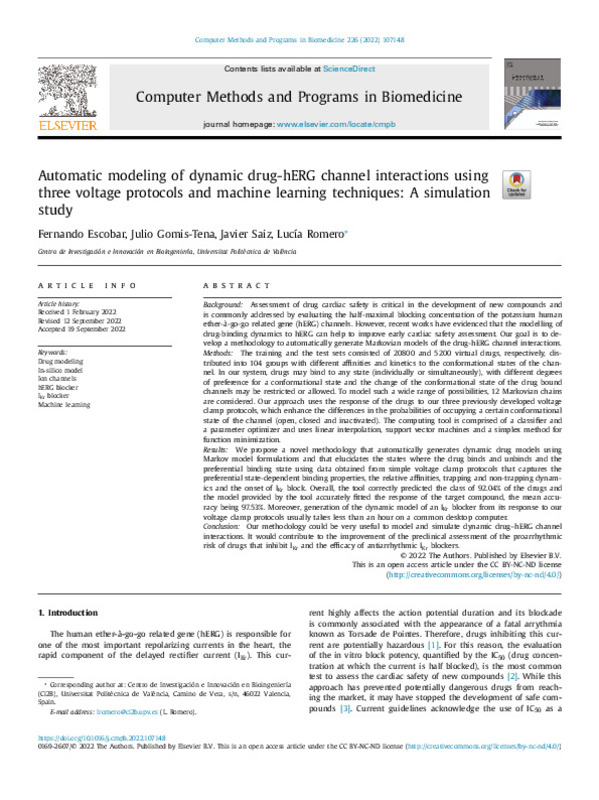JavaScript is disabled for your browser. Some features of this site may not work without it.
Buscar en RiuNet
Listar
Mi cuenta
Estadísticas
Ayuda RiuNet
Admin. UPV
Automatic modeling of dynamic drug-hERG channel interactions using three voltage protocols and machine learning techniques: A simulation study
Mostrar el registro sencillo del ítem
Ficheros en el ítem
| dc.contributor.author | Escobar-Ropero, Fernando
|
es_ES |
| dc.contributor.author | Gomis-Tena Dolz, Julio
|
es_ES |
| dc.contributor.author | Saiz Rodríguez, Francisco Javier
|
es_ES |
| dc.contributor.author | Romero Pérez, Lucia
|
es_ES |
| dc.date.accessioned | 2023-01-19T19:01:07Z | |
| dc.date.available | 2023-01-19T19:01:07Z | |
| dc.date.issued | 2022-11 | es_ES |
| dc.identifier.issn | 0169-2607 | es_ES |
| dc.identifier.uri | http://hdl.handle.net/10251/191406 | |
| dc.description.abstract | [EN] Background: Assessment of drug cardiac safety is critical in the development of new compounds and is commonly addressed by evaluating the half-maximal blocking concentration of the potassium human ether-à-go-go related gene (hERG) channels. However, recent works have evidenced that the modelling of drug-binding dynamics to hERG can help to improve early cardiac safety assessment. Our goal is to de- velop a methodology to automatically generate Markovian models of the drug-hERG channel interactions. Methods: The training and the test sets consisted of 20800 and 5200 virtual drugs, respectively, dis- tributed into 104 groups with different affinities and kinetics to the conformational states of the chan- nel. In our system, drugs may bind to any state (individually or simultaneously), with different degrees of preference for a conformational state and the change of the conformational state of the drug bound channels may be restricted or allowed. To model such a wide range of possibilities, 12 Markovian chains are considered. Our approach uses the response of the drugs to our three previously developed voltage clamp protocols, which enhance the differences in the probabilities of occupying a certain conformational state of the channel (open, closed and inactivated). The computing tool is comprised of a classifier and a parameter optimizer and uses linear interpolation, support vector machines and a simplex method for function minimization. Results: We propose a novel methodology that automatically generates dynamic drug models using Markov model formulations and that elucidates the states where the drug binds and unbinds and the preferential binding state using data obtained from simple voltage clamp protocols that captures the preferential state-dependent binding properties, the relative affinities, trapping and non-trapping dynam- ics and the onset of I Kr block. Overall, the tool correctly predicted the class of 92.04% of the drugs and the model provided by the tool accurately fitted the response of the target compound, the mean accu- racy being 97.53%. Moreover, generation of the dynamic model of an I Kr blocker from its response to our voltage clamp protocols usually takes less than an hour on a common desktop computer. Conclusion: Our methodology could be very useful to model and simulate dynamic drug¿hERG channel interactions. It would contribute to the improvement of the preclinical assessment of the proarrhythmic risk of drugs that inhibit I Kr and the efficacy of antiarrhythmic I Kr blockers. | es_ES |
| dc.description.sponsorship | This work was the Spanish Ministerio de Ciencia, Innovacion y Universidades [grant "Formacion de Profesorado Universitario" FPU19/02200; grant PID2019-104356RB-C41 funded by MCIN/AEI/10.13039/50110 0 011033 ]; the European Union's Horizon 2020 research and innovation program [grant agreement No 101016496 (SimCardioTest)]; and the Direccion General de Politica Cientifica de la Generalitat Valenciana [grant PROMETEO/2020/043]. Patenting of the proposed system/software is under consideration | es_ES |
| dc.language | Inglés | es_ES |
| dc.publisher | Elsevier | es_ES |
| dc.relation.ispartof | Computer Methods and Programs in Biomedicine | es_ES |
| dc.rights | Reconocimiento - No comercial - Sin obra derivada (by-nc-nd) | es_ES |
| dc.subject | Drug modeling | es_ES |
| dc.subject | In-silico model | es_ES |
| dc.subject | Ion channels | es_ES |
| dc.subject | HERG blocker | es_ES |
| dc.subject | I Kr blocker | es_ES |
| dc.subject | Machine learning | es_ES |
| dc.subject.classification | TECNOLOGIA ELECTRONICA | es_ES |
| dc.title | Automatic modeling of dynamic drug-hERG channel interactions using three voltage protocols and machine learning techniques: A simulation study | es_ES |
| dc.type | Artículo | es_ES |
| dc.identifier.doi | 10.1016/j.cmpb.2022.107148 | es_ES |
| dc.relation.projectID | info:eu-repo/grantAgreement/AEI/Plan Estatal de Investigación Científica y Técnica y de Innovación 2017-2020/PID2019-104356RB-C41/ES/MODELO MULTIESCALA DE PATOLOGIAS CARDIACAS Y OPTIMIZACION DE TERAPIAS PERSONALIZADAS/ | es_ES |
| dc.relation.projectID | info:eu-repo/grantAgreement/GENERALITAT VALENCIANA//PROMETEO%2F2020%2F043//MODELOS IN-SILICO MULTI-FISICOS Y MULTI-ESCALA DEL CORAZON PARA EL DESARROLLO DE NUEVOS METODOS DE PREVENCION, DIAGNOSTICO Y TRATAMIENTO EN MEDICINA PERSONALIZADA (HEART IN-SILICO MODELS)/ | es_ES |
| dc.relation.projectID | info:eu-repo/grantAgreement/EC/H2020/101016496/EU | es_ES |
| dc.rights.accessRights | Abierto | es_ES |
| dc.contributor.affiliation | Universitat Politècnica de València. Escuela Técnica Superior de Ingenieros Industriales - Escola Tècnica Superior d'Enginyers Industrials | es_ES |
| dc.description.bibliographicCitation | Escobar-Ropero, F.; Gomis-Tena Dolz, J.; Saiz Rodríguez, FJ.; Romero Pérez, L. (2022). Automatic modeling of dynamic drug-hERG channel interactions using three voltage protocols and machine learning techniques: A simulation study. Computer Methods and Programs in Biomedicine. 226:1-10. https://doi.org/10.1016/j.cmpb.2022.107148 | es_ES |
| dc.description.accrualMethod | S | es_ES |
| dc.relation.publisherversion | https://doi.org/10.1016/j.cmpb.2022.107148 | es_ES |
| dc.description.upvformatpinicio | 1 | es_ES |
| dc.description.upvformatpfin | 10 | es_ES |
| dc.type.version | info:eu-repo/semantics/publishedVersion | es_ES |
| dc.description.volume | 226 | es_ES |
| dc.identifier.pmid | 36170760 | es_ES |
| dc.relation.pasarela | S\475081 | es_ES |
| dc.contributor.funder | GENERALITAT VALENCIANA | es_ES |
| dc.contributor.funder | AGENCIA ESTATAL DE INVESTIGACION | es_ES |
| dc.contributor.funder | COMISION DE LAS COMUNIDADES EUROPEA | es_ES |
| dc.contributor.funder | MINISTERIO DE UNIVERSIDADES E INVESTIGACION | es_ES |
| dc.contributor.funder | Universitat Politècnica de València | es_ES |








